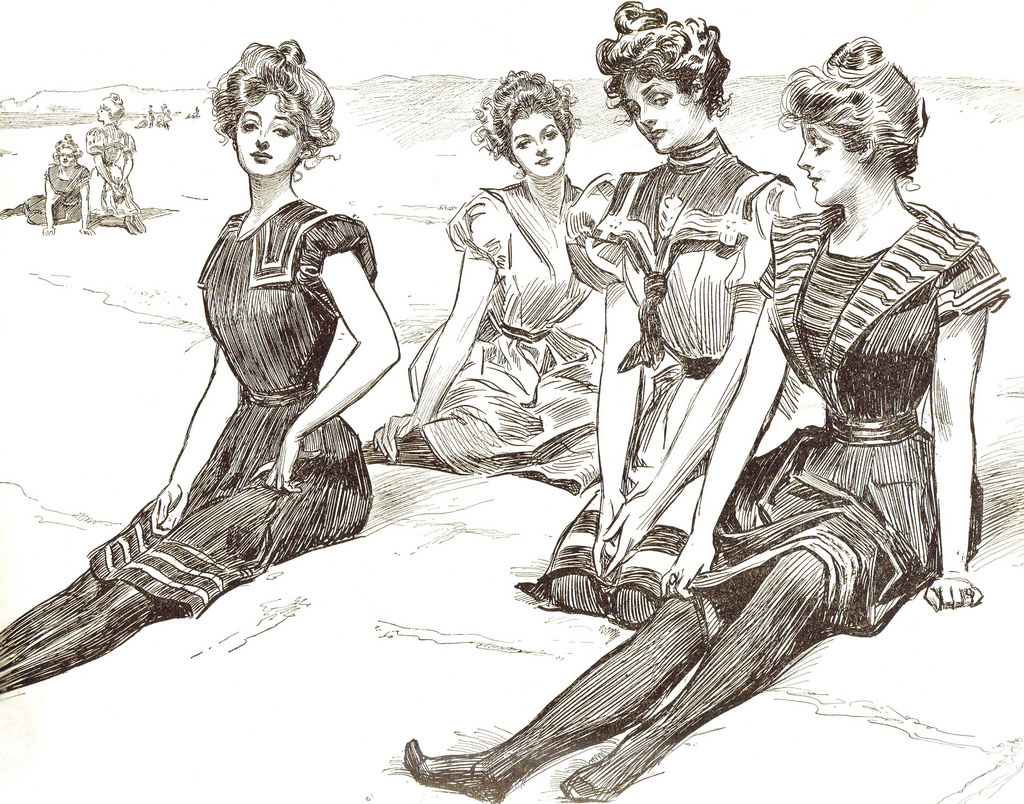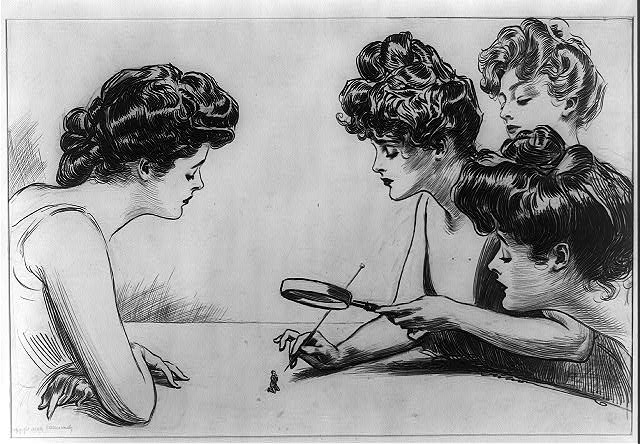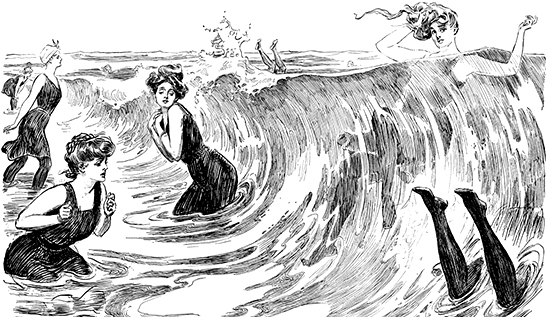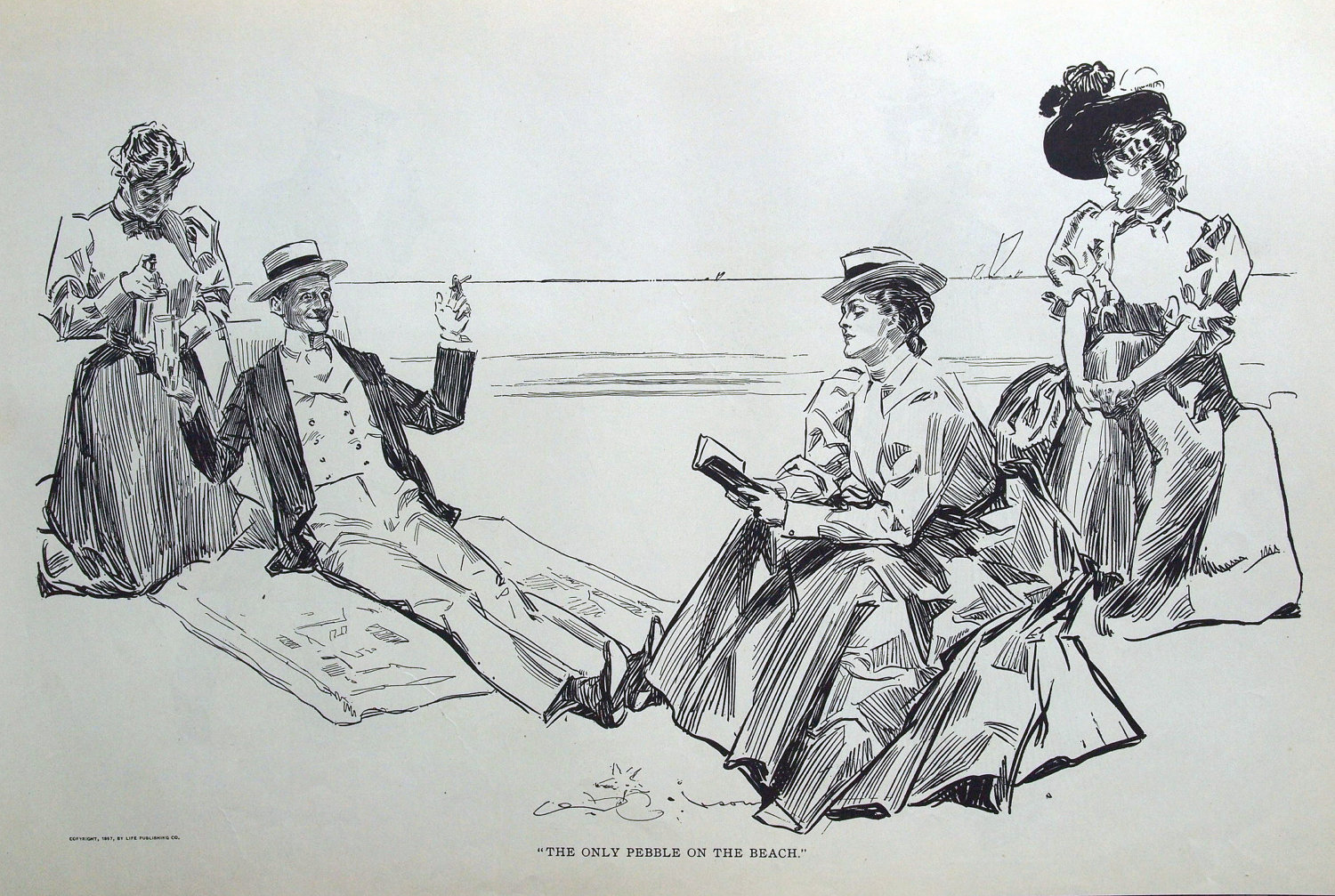Charles Dana Gibson, American illustrator, renders “proper” beach wear for young ladies, circa 1905.

Charles Dana Gibson (~1905)
I wish Americans would look at themselves and their own history, before they talk about how benighted other cultures are. They’re not wearing niqab, but they’re wearing stockings and corsets. At the beach.
It’s hard to look at Gibson’s work and not see it for its classism as well as racism and misogyny. Women are represented as either manipulative, or frail.
Well, which is it?

“The weaker sex”
Dissecting a 1900s MRA?

Or helpless in front of water?
Or bored to tears? You can practically hear their optic nerves straining as they roll their eyes.

“Mansplaining” at the beach

They’re all white, too. For some reason. Interesting.
kestrel@#1: racism, classism – it’s hard to untangle them. For sure no proper young lady’d show an ankle at the beach…
And “proper” young ladies are not even tan, let alone nonwhite.
It’s daytime now! Only a dolt, however, thinks that means it’s always been daytime. On the other hand, given that it demonstrably is daytime, it’s not unreasonable to view the people still walking round with torches claiming they can’t see things in the gloom as rather odd… “benighted”, you might call them.
These pictures are from over 100 years ago. What’s interesting about them, to us, is how different they are from what prevails now. That’s indicative of progress. It might be instructive to compare pictures of what cultures now recommending the burqini thought acceptable 100, 200 or 600 years ago. It might be possible to draw conclusions about progress there, too.
sonofrojblake:
It would facilitate my contemplation were you to enumerate the set of cultures which now recommend the burkini.
(Also, what’s this “going to the beach” thingy, with which cultures were engaged 100, 200 or 600 years ago?)
PS I do take your point, SOJB: Wimple?
Has anyone demonstrated a way to tell me in a hooded wetsuit from a muslim in a DIY burkini?
I’d hate to think that the ban was a petty, poorly-thought-through snafu that sought to limit freedom of expression without just cause or even a mechanism for sussing out offenders…
John Morales, 4:
You appear unwilling or unable to use Google. I don’t think I can help you.
Also, are you really unfamiliar with the concept of visiting littoral regions for recreation and relaxation? Or are you under the impression that this activity is a modern invention?
sonofrojblake, righto. You imagine I appear unwilling or unable to use Google, amongst other imaginings. That I can’t dispute.
(What is perfectly clear is that you don’t care to sustain your claim by naming even one such culture; your reticence is telling)
Interestingly, I have read that the burkini is actually an invention of Australian muslim women, as a compromise between the usual heavy, concealing garb and the desire to go to the beach. It provided an avenue to visit and even swim at the beach without breaching their religious clothing requirements, and so opened the beach to that population.
(A more rational option would be to abandon the religious requirement for concealment, but baby stills are still progress.)
@John Morales, 7:
What claim?
@Holms, 8: With reference to your final parenthetical point, I agree, but I’m curious what it is you are distilling off babies…
You know, you don’t have to go back 100 years.
Last week I read an article about a girl in Kansas(?) who was made to change into a track suit for wearing inappropriate and too revealing clothing.
There was a picture.
She wore dark leggins with a big rose print.
She wore a shirt that fell lightly over her butt, one of these loose things halfway between a dress and a shirt.
She was 11 years old.
Personally, I want anybody to be permanently banned from schools who thinks an 11 year old can be sexually provocative, no matter what she’s wearing.
Holms
Well, a German court decided that a muslim girl had to take part in school swimming because she can wear a burkini.
Just for the record, it was the girl who sued. Her parents didn’t.
sonofrojblake@#3:
Well, French society had women wearing a gigantic amount of stuff with corsetry and hoops and often a great big head-wad. Ottoman society had some pretty interesting womens’ wear but they were mostly closeted away. It’s hard to trust “orientalist” images, though, because they were often fantastical/eroticized (and usually the women were strangely white) …
I have always loved Gibson’s work; it’s undeniably eroticized if not outright fetishistic.
Also, are you really unfamiliar with the concept of visiting littoral regions for recreation and relaxation?
Did the Roman women at Pompeii stay in the villa and drink? I don’t recall whether lounging about on the beach was done.
Basically correct, albeit with the caveat it was never intended only for Muslim women, according to an article by the inventor (Aheda Zanetti), I created the burkini to give women freedom, not to take it away:
As numerous people have pointed out, both wetsuits and nun’s habits should also be banned using the same spurious “logic” behind the burkini ban.
(I happen to live in one of the French villages which foolishly banned the burkini. Wetsuits are common here, albeit I have no clear memory of seeing any nuns — or burkinis — on the beaches.)
blf, how did the French laws define the prohibited outfits? Was it just about length and body parts that were covered or did the law specify items with religious connotations? Because elsewhere some apologist claimed the latter (making it seem that the Muslim women could bypass the law by wearing wetsuits).
In either case, a perfectly secular wetsuit would get covered in the blast damage. If I spiced up my hooded wetsuit with a skirt, how would that be visibly different from a Burkini?
If the last picture’s to be trusted, though, men were just as overdressed by our standards.
anat
Well, since France decided that long skirts in muslim girls are religious symbols and must not be worn to school I guess the difference is “worn by a woman who looks like she could conceivably be muslim”. In short a “secular” law that specifically targets a minority religion.
+++
Has anybody noticed a tendency? sonofrojblake will barge into these threads, protector and lberator of women if they want it or not and then quietly disappear when his arguments are challenged…
springa73@#18:
They were. There were certain things you simply did not do if you were a proper christian American man, such as go outdoors without a hat. That was, generally, a symbol of class more than anything else, though (big hats!) its origin was christian via judaism.
Giliell@#19:
Are crucifixes also deprecated? Aha, I see that it’s a blanket ban. I wonder if it’s enforced evenly.
I am unimpressed with France’s charcuterie-fisted approach to dealing with religious displays. Tsk! The cradle of the enlightenment, trying to legislate fashion!
Marcus Ranum
I haven’t heard of good catholic schoolkids being stripsearched to see if there’s a little tortured Jesus in the necklace under their shirt…
But long black skirts are something probably 50% of women have in their wardrobes, so to shame muslim girls for wearing them can only be described as bullying.